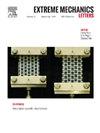通过纺丝诱导的纤维蛋白微观结构致密化和凝块体积减小治疗凝块
IF 4.5
3区 工程技术
Q2 MATERIALS SCIENCE, MULTIDISCIPLINARY
引用次数: 0
摘要
血凝块是由嵌在纤维蛋白网络中的红血球(rbc)组成的,可导致危及生命的疾病,如中风和心脏病发作。然而,传统的取栓技术,如抽吸或支架回收,往往与大的或坚硬的血栓作斗争,限制了它们的临床疗效。最近开发的微旋血栓切除术提供了一种突破性的方法,从根本上脱离了这些传统方法。与完整提取凝块不同的是,微纺丝机通过压缩和剪切力的共同作用使其微观结构致密化,从而使凝块机械收缩,体积减少高达95% %。这种新颖的凝块减容策略能够更有效地去除凝块,并具有显著改善血栓切除术临床结果的强大潜力。为了揭示潜在的机制并优化性能,我们将体外实验与耗散粒子动力学(DPD)模拟相结合,对综合压缩和剪切作用下的凝块体积缩小和微观结构致密化进行了多尺度分析。实验量化了控制负荷下宏观的血块体积减少,而模拟揭示了微观尺度的纤维蛋白网络致密化和红细胞释放。这个系统的研究提供了一个定量的了解不同的加载模式如何改变凝块的微观结构跨越凝块类型。这些发现为下一代取栓系统的合理设计奠定了基础,该系统能够在原位机械地重新配置凝块微观结构,从而提高疗效和更广泛的临床适用性。本文章由计算机程序翻译,如有差异,请以英文原文为准。
Clot treatment via spinning-induced fibrin microstructure densification and clot volume reduction
Blood clots, composed of red blood cells (RBCs) embedded within a fibrin network, can cause life-threatening conditions such as strokes and heart attacks. However, conventional thrombectomy techniques, such as aspiration or stent retrievers, often struggle with large or tough clots, limiting their clinical efficacy. The recently developed milli-spinner thrombectomy offers a breakthrough approach that fundamentally departs from these traditional methods. Instead of extracting the clot intact, the milli-spinner mechanically shrinks the clot by densifying its microstructure through the combined action of compression and shear forces, achieving up to 95 % volume reduction. This novel clot debulking strategy enables more effective clot removal and holds strong potential for significantly improved clinical outcomes in thrombectomy procedures. To uncover the underlying mechanisms and optimize performance, we combine in vitro experiments with dissipative particle dynamics (DPD) simulations for multiscale analysis of clot volume reduction and microstructural densification under integrated compression and shear. Experiments quantify macroscopic clot volume reduction under controlled loading, while simulations reveal microscale fibrin network densification and RBC release. This systematic study provides a quantitative understanding of how different loading modes alter clot microstructure across clot types. These findings lay the foundation for the rational design of next-generation thrombectomy systems, capable of mechanically reconfiguring clot microstructure in situ, offering enhanced efficacy and broader clinical applicability.
求助全文
通过发布文献求助,成功后即可免费获取论文全文。
去求助
来源期刊

Extreme Mechanics Letters
Engineering-Mechanics of Materials
CiteScore
9.20
自引率
4.30%
发文量
179
审稿时长
45 days
期刊介绍:
Extreme Mechanics Letters (EML) enables rapid communication of research that highlights the role of mechanics in multi-disciplinary areas across materials science, physics, chemistry, biology, medicine and engineering. Emphasis is on the impact, depth and originality of new concepts, methods and observations at the forefront of applied sciences.
 求助内容:
求助内容: 应助结果提醒方式:
应助结果提醒方式:


